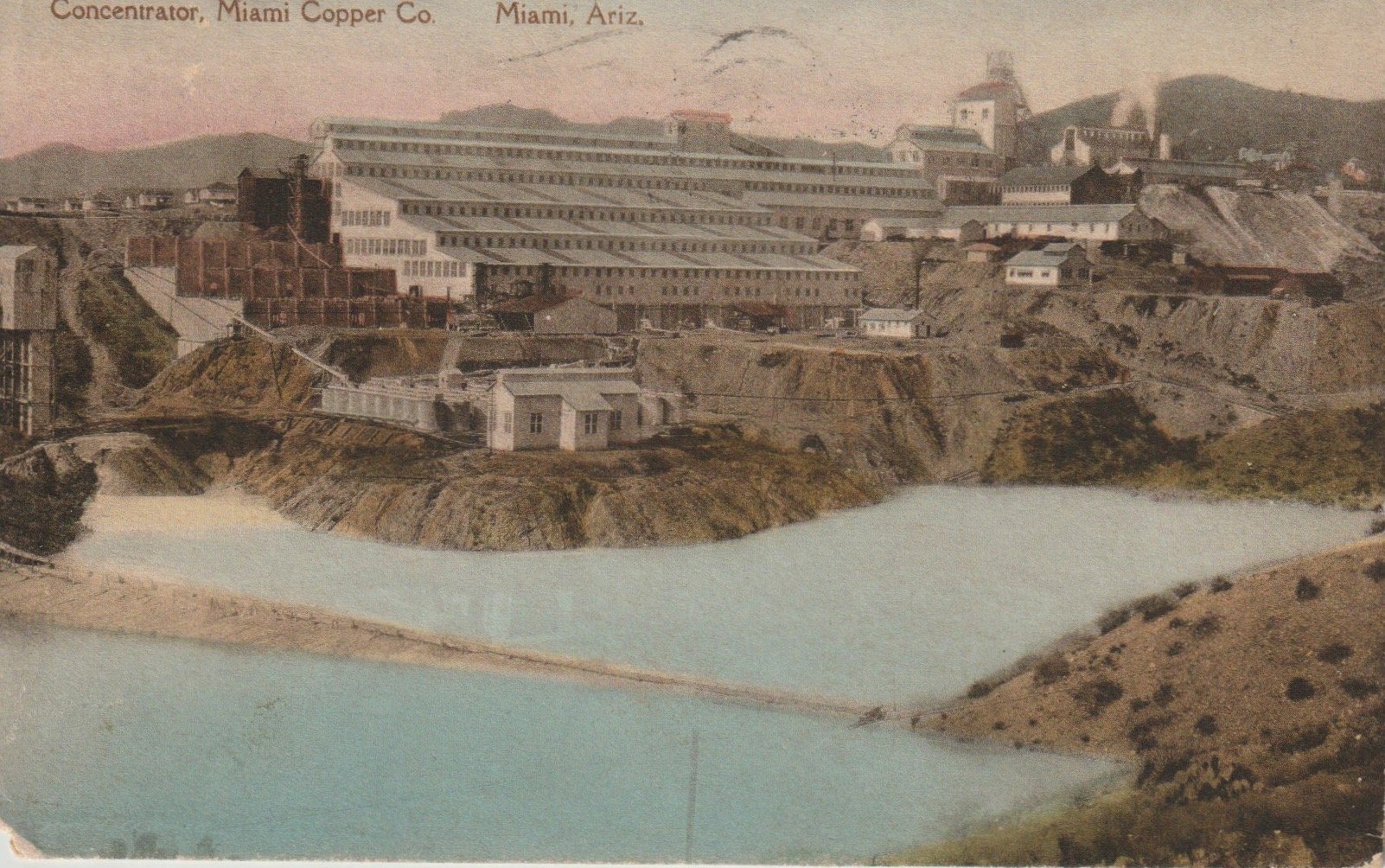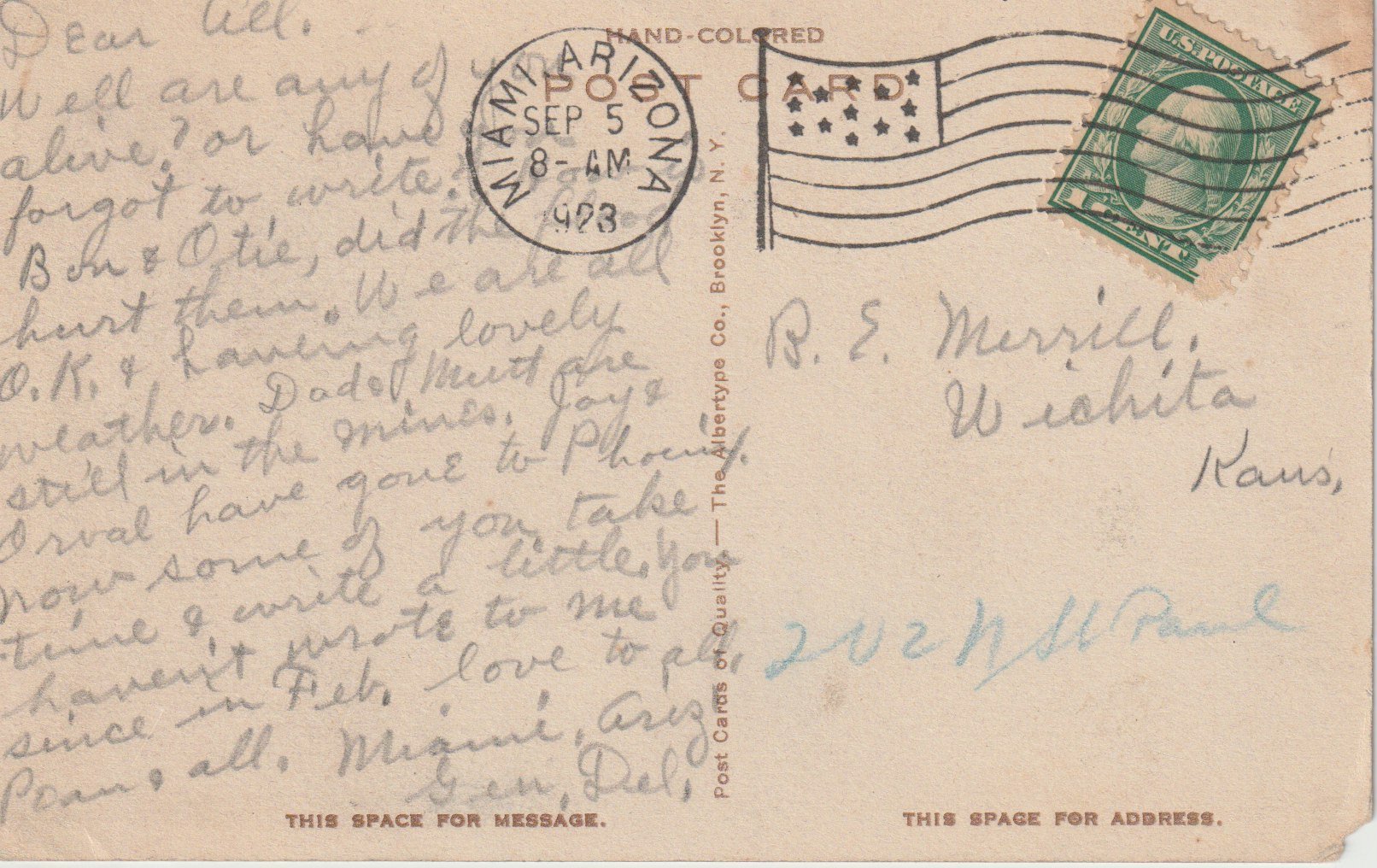
WELL ARE ANY OF YOU ALIVE?
The card begins with the question above and ends with the plea, “Now some of you take time & write a little.”
September 5, 1923, Miami, Arizona.
From the time I moved to Arizona and heard the name of the town, Miami, I was puzzled. I knew Miami, Florida and I could not imagine a more diametrically opposed, identically named town. In my mind, Miami is a lush, sub-tropical, steamy, cosmopolitan, beach city. On a recent visit to Arizona, specifically driving through Miami, I looked up the origin of the name Miami. I found a number of references, but none seem to fit; a native tribe in Indiana or “big water” in a native language, another story about the founder and his wife’s name – Mima, somehow morphing to Miami.
Globe, Miami and Superior are all small towns, located near one another, boom and bust, surviving today, mining economies all. They all survive unlike the many, many ghost towns and resurrected ghost towns sprinkled throughout Arizona.
He or she writes:
“Dear All, Well are any of you alive? Or have you forgot to write? How is Ben and Otie, did the flood hurt them? We are all O.K. and having lovely weather. Dad and Mutt are still in the mines. Jay & Orval have gone to Phoenix. Now some of you take time & write a little. You haven’t wrote to me since in Feb. love to all. Poam & all. Miami, Ariz. Gen. Del.”

The postcard itself is a picture of the concentrator at Miami. This was the place the rocks from the mine were taken, crushed and the copper pulled out of the rock it was found in. There’s much more to it, but think – crushed rock and then through chemical treatment, the actual copper is “concentrated”. In the early years of this mine, people wrote about how the heaps of metal and waste would glow in the night, adding to the rather surreal place, time and juncture of these people.
The writer evokes in me outright sad and lonely feelings. The story I have in my mind is about a family unit, leaving the farming mid-west and traveling to this unknown place, Miami, Arizona to mine. These mines produced silver and copper, depending upon the price of each, the cost of mining and transporting the needed materials and the ore. This is as different from Kansas as one might find anywhere. The vegetation, rains (boom or bust), economy, mix of people, Indians, animals, and the unrelenting vivid blue desert sky.
I’ve been to Miami – Globe and Superior – mining towns near one another many, many times. Downtown Miami is old buildings, streets, bars, antique stores and the bridges, stairways and sidewalks of the mining west. While I could not figure out where exactly the name Miami originated, I did discover that Globe was named for a globe of silver, 9 inches in diameter.
The clear, blue brilliant skies, wind in the hills, quiet that is only found in these places is a treasure. I wonder what those first settlers thought. I wonder what they thought about the ruins in the area, or finding pottery, or the Apaches.
In 1922, the Apache Trail, a highway was opened from Phoenix, through other towns to Miami – Globe. The mines Miami-Globe Copper Mines were named the #1 Wonder of the West – with sites like the cliff dwellings of long gone native Americans, ranked #3. The Petrified Forest and Grand Canyon ranked #6 and #7 respectively. Clearly, copper was reigning king in those days.
I love this area for the echoes of long gone people – those miners, their wives, children, siblings who came and made this a town. Humans have inhabited the area for thousands of years. Hunter-gatherer evidence can be found, followed by later settlements, then the Salado culture, best seen in Besh-Ba-Gowah, a pueblo ruin on an idyllic hill in Globe. This museum and partially reconstructed ruin has one of the largest collections of Salado artifacts anywhere. These people were followed by the Apache, who named the ruins. The name means place of metal. They were joined by and warred with white settlers, miners and all the people who came along for the boom times.
When I walk Miami streets, poke around in antique stores and peer between boards of abandoned buildings, I think about all the people who came before; seeking water, food, metals, land, and something they couldn’t find elsewhere. What was it that lead the writer and family to the very wild west? How long did they stay, or did they leave? Did they find that thing they were seeking in the mountain valleys of Arizona? The quiet breeze whispers down the ages of human habitation. What will come next for these valleys and these people?
Until the next adventures through centuries of history – both human and natural.
Sherry
Share this post:






POST COMMENT